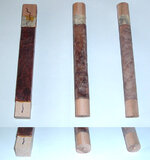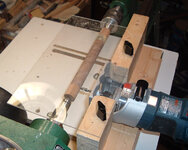Dale Allen
Member
I finally finished this project. The real reason it took so long is that I was constantly trying to work out the process in my head and decide if it was safe.
These are the blanks I use for the cigar pens. My process is to glue the pieces, sand the sides even, mark and drill the ends with a center bit and run them through a round over bit on the router table. From there it previously took me about 30 minutes to turn the blank round and make sure it was a consistent diameter.
Now it takes about 6 minutes.
The fixture was previously made for milling operations but that did not work out too well. So I adapted my Colt palm router to it and this works great using a 1/4" up spiral bit. The router is mounted to a carriage that moves back and forth on 2 heavy duty drawer slides. It does not leave a real smooth finish but some sandpaper from this point does the trick.
BTW, I run the lathe at the slowest speed while the router bit is cutting.
These are the blanks I use for the cigar pens. My process is to glue the pieces, sand the sides even, mark and drill the ends with a center bit and run them through a round over bit on the router table. From there it previously took me about 30 minutes to turn the blank round and make sure it was a consistent diameter.
Now it takes about 6 minutes.
The fixture was previously made for milling operations but that did not work out too well. So I adapted my Colt palm router to it and this works great using a 1/4" up spiral bit. The router is mounted to a carriage that moves back and forth on 2 heavy duty drawer slides. It does not leave a real smooth finish but some sandpaper from this point does the trick.
BTW, I run the lathe at the slowest speed while the router bit is cutting.



